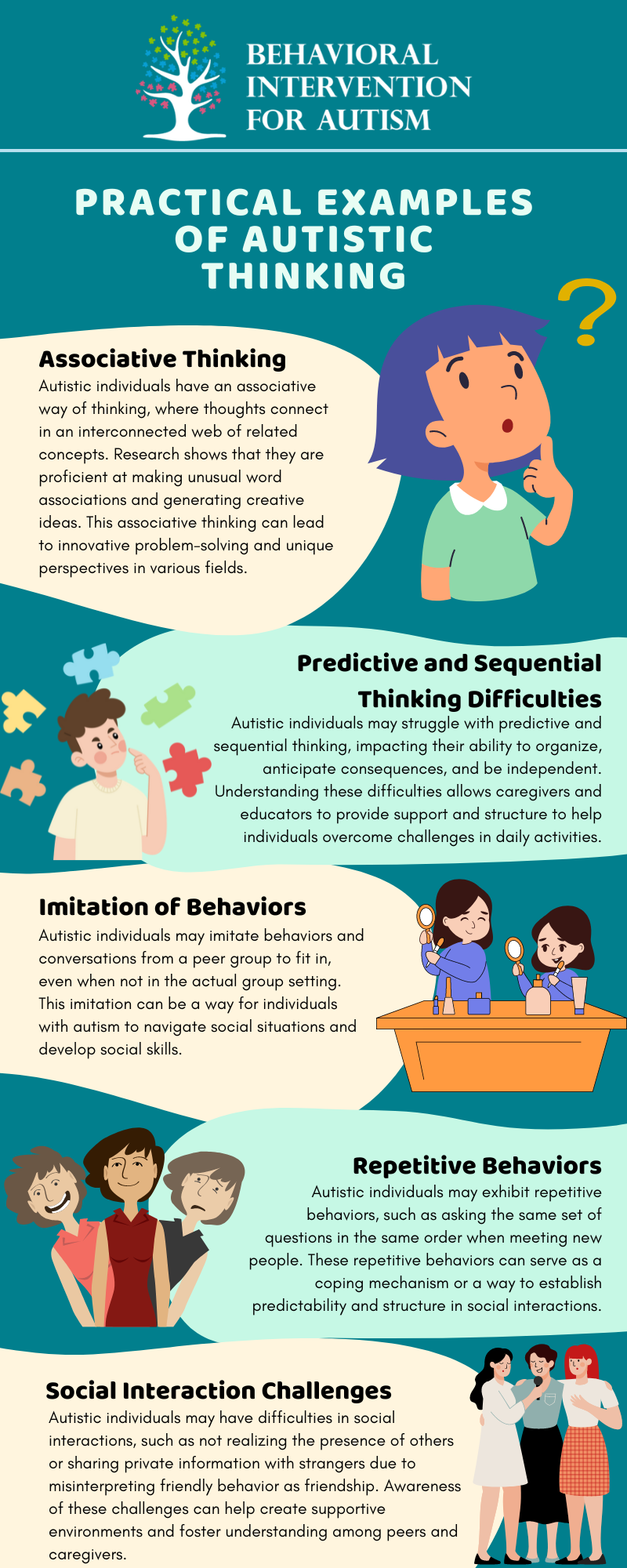
Table of Contents
To understand autistic thinking, we have to recognize and appreciate the different cognitive styles that individuals on the autism spectrum may possess. Temple Grandin, a renowned scientist and autism spokesperson, identified three specialized cognitive types in autistic individuals: visual thinkers, verbal/logic thinkers, and pattern thinkers.

Characteristics of Each Thinking Style
Visual thinkers have a unique way of processing information. They possess the ability to think in a photo-realistic manner, which allows them to form concepts by sorting pictures into categories. Their thinking style is associative, linking thoughts that share a common basic element, even if they are not sequentially related. This cognitive style can lead to creative problem-solving and intuitive insights.
Meanwhile, verbal/logic thinkers excel in areas that involve language and logical reasoning. They have a strong memory for verbal facts and are skilled at making lists and categorizing information.
These individuals may find it easier to express themselves verbally and possess a deep understanding of linguistic concepts. However, they may struggle with visual thinking skills and may face challenges in processing information that is primarily visual or spatial.
On the other hand, pattern thinkers have a natural inclination toward recognizing patterns and relationships between numbers. They may display strengths in areas such as music and math, where pattern recognition is essential. These individuals excel in abstract thinking and have the ability to perceive connections that others may not readily notice.
However, they may experience difficulties in areas like reading and writing composition, which rely heavily on sequential and linear thinking.
Unique Thinking Patterns in Autism
Autistic thinking is characterized by unique cognitive styles and patterns that differ from neurotypical thinking. Understanding these thinking patterns can provide valuable insights into the minds of individuals with autism.
Logical Consistency in Autistic Thinking
Autistic individuals often exhibit a heightened level of logical consistency in their thinking. Research suggests that they reason in a more consistent manner compared to neurotypicals, showing decreased susceptibility to cognitive biases like the framing effect.
This means that they are less influenced by the way information is presented and are more likely to base their conclusions on the logical merits of the information itself.
The enhanced logical consistency in autistic thinking can manifest in various ways. Autistic individuals may excel in tasks that require logical reasoning, problem-solving, and attention to detail. They may have a remarkable ability to identify inconsistencies or contradictions in information and find logical solutions to complex problems.
This unique thinking pattern can have both advantages and challenges. While it allows for precise and accurate reasoning, it may also lead to difficulties in flexible thinking or adapting to changing circumstances.
Associative Thinking in Autism
Associative thinking is another prominent characteristic of autistic thinking.
Autistic individuals have a natural tendency to make connections between thoughts and concepts in an interconnected web. This associative thinking style allows them to generate creative ideas and make unusual word associations.
The ability to think associatively can lead to unique perspectives and insights. Autistic individuals often approach problem-solving by considering multiple angles and connections between seemingly unrelated ideas. This cognitive style can result in innovative solutions and novel approaches to various tasks.
However, associative thinking can also present challenges in certain situations. Autistic individuals may struggle with linear thinking or following a strictly sequential thought process.
This can sometimes make it difficult to navigate tasks that require step-by-step instructions or rigid adherence to specific procedures.
Practical Implications of Autistic Thinking
To understand autistic thinking, we have to look at practical implications that can be beneficial for individuals on the autism spectrum as well as those who interact with them. There are two key aspects to this which are as follows:
Attention to Detail
Autistic individuals often possess a remarkable attention to detail. This keen eye for detail can prove to be advantageous in various tasks and activities.
For example, David, a 27-year-old with Asperger’s syndrome, excels in his part-time job at a bookstore due to his ability to maintain well-stocked and organized bookshelves. His attention to detail ensures that books are neatly arranged, making it easier for customers to find what they are looking for.
This level of precision and meticulousness can contribute to the success of individuals with autism in environments that require organization and attention to detail.
Functional Examples of Autistic Thinking
Autistic thinking is characterized by unique patterns that differ from neurotypical thinking. These thinking patterns can have functional implications in various aspects of life.
Let’s explore some practical examples of autistic thinking:
Understanding the practical implications of autistic thinking allows us to appreciate the unique strengths and challenges of individuals on the autism spectrum.
By embracing and accommodating these thinking patterns, we can create inclusive environments that celebrate diversity and provide the necessary support for individuals with autism to thrive.
Discover how our high-quality ABA therapy in Florida can help you. Get in touch to learn more and start making a positive impact on your child’s development.
Sources:
https://www.scottishautism.org/about-autism/about-autism/thinking-styles
https://embrace-autism.com/thinking-styles-in-autistic-people
https://kennethrobersonphd.com/three-thinking-styles-of-adults-with-aspergers
- From Macedonia to Florida: Autism Shaped FAU Coach’s Path - November 7, 2024
- Clinic-Based Therapy Vs In-Home Therapy in Florida: Making the Right Choice for Your Child - November 7, 2024
- Understanding Pharmacogenetics in Autism Treatment Options - November 6, 2024



